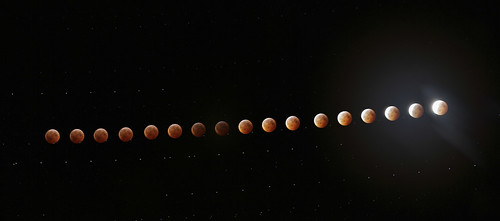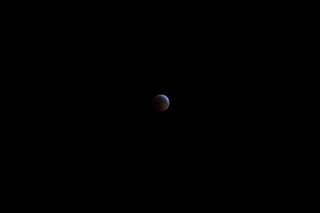
A photo-shopped composite of 17 photographs...
Continue to see how this image came about...
Several factors went into this particular image.
I was pretty busy at work and with some personal stuff, so no planning went into the image prior to actually taking the photos.
The first surprise was a good one. It had been cloudy and raining for the last several days, and the forecast was cloudy for that night as well. As it happened, all the clouds disappeared for a few hours around the eclipse. Woo hooo!!!
The longest lens I had on hand was 210mm. That really wasn't a surprise but I haven't shot the moon at that length before, so I fired a test shot, and as you can see, the closest that I could get to the moon was not close at all.
 |
| Moon at 200mm (on full frame camera) |
The Shot(s)
Regardless, I decided to go the other way, and shoot at 70mm (the longest length on my 24-70). I thought it'd be nice to open it to f/2.8 and capture the stars as well as the moon.
Shooting just the moon, I would probably have shot hand-held (the moon is very bright - pretty much like shooting outdoors on a sunny day - actually, very much like it as on a sunny day things are lit by sunlight, and think about it so is the moon).
However, the eclipse changes that. As the earth's shadow covers the moon, it gets darker and darker till totality, and then starts getting brighter again.
That, plus shooting a bigger area meant a longer exposure, as I wanted to show the stars. Without the stars, the wider-angle means nothing. The stars give the viewer perspective of the whole sky and make the moon shot interesting. At least, that was what I was thinking at that time.
So out came the tripod. I set it up and tried a couple of different exposure settings, and settled on 5 second exposures at f/2.8 and ISO 100. I had been out in the evening, and by the time I started shooting most of the moon was in eclipse.
I would take a photo and check the exposure and composition, and by the time I took the next photo, the composition would be changed. Took me a couple of minutes to realize why that was.
Stop and think about it now if you'd like to figure it out on your own.
 |
| Moon at 70mm, 5 sec, f/2.8, ISO 100 |
The moon (and the sun) is constantly move across the sky due to the earth's rotation, of course. Just staring at the sky or the moon, it's easy to not notice it - even though we know it pretty well.
That's when the idea for this image came into mind.
To make it happen, I positioned the moon in the bottom left area of the photo, and through my laptop, started shooting 5 sec exposures every minute. The camera software comes with an excellent intervalometer.
After about 40 minutes or so, the clouds rolled in and covered the moon totally, so that was that.
The Final Image
The next day, I went into Photoshop (PSE 2.0), and put all the photographs as layers on top of the first one. Then I blended each layer with the previous layer using "lighten" mode. This compares the two layers and makes the result using the "lighter" areas of the two layers - exactly what I wanted.
Using the 1-minute interval photographs, each moon was touching the moon from the previous and the next photographs, and I thought it made it too cluttered. So I removed each middle photograph (turned off the layers, actually), and made it a 2-minute interval between the photographs.
Then, I cropped the image to remove the uninteresting black space around the moon sequence.
That's the final result you see on top.
Still to do
Looking at the final result, I don't really like the stars in the photographs anymore. If I was to do it again, I'd choose a different exposure, and get rid of the stars. Currently the only option is to go into photoshop and clean out 17 photographs manually, and then blend them again.
Maybe if I'm bored enough one of these days...
No comments:
Post a Comment